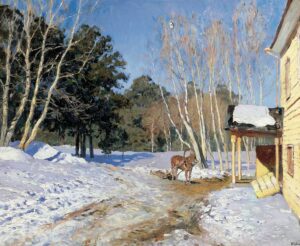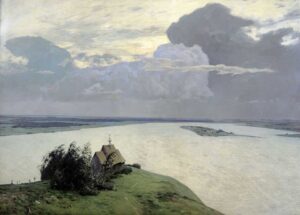
Over Eternal Peace (1894)
by Colin Fell in Cornwall

Before me on my desk as I write is a thin sheet of orange plastic. It is the outline of what was, to a child growing up in England at the height of the Cold War, the known world of Europe. In our geography lessons we would place this template on our paper, and with our pencils laboriously describe a geopolitical journey; I imagine my adolescent self, voyaging vicariously around Britain’s intriguing yet familiar coastline, then along the North Sea coast, before arriving at the mysteriously named triad of Baltic republics of which we knew so little. Beyond Estonia, the map’s own iron curtain descended, in the form of its plastic frame. Here Endeth Europe, was the message clearly implied to our young minds; beyond lay…what, precisely? The TV was little help to one attempting to imagine the unknowable, unmapped vastness we knew to exist – grainy, smudgy black and white newsreel of the occasional Russian dissident, or coverage of the May Day parades of military hardware in Red Square.
But I did know differently – my father, a Russophile, bought LPs of the Russian orchestral canon – Tchaikovsky, Rachmaninov, Shostakovich – and as was the wonderful fashion of the time, those tempting canvases, the record sleeves, were decorated with art work offering a visual key to the emotional content of the music etched into the shiny black vinyl within. And so it was that I came to discover a love, not only of the music, but of the art of someone still very little known in the West, Isaac Levitan. This was developed when my father, ever keen to encourage learning, managed somehow to obtain a gorgeously printed and bound book of Levitan’s work, from the Aurora press in Leningrad.
Born into a lower middle class but educated Jewish family in a shtetl in Kybartai, in what is now Lithuania, Isaac Levitan suffered from the Anti-Semitism of the period, and was briefly banished from Moscow as a Jew in reaction to the assassination attempt on Tsar Alexander II. Interestingly, my Aurora press book makes only passing reference to Levitan’s Jewishness, and none of his banishment. His later friendship with Chekhov, with whose sister he was rumoured to be in love, helped to secure his return to Moscow and his ability to continue working, until his untimely death at 40. His subject matter was unfathomable dark lakes and mill ponds, mysterious onion-domed churches rising from hayfields, and paths, lots of paths, and roads, winding mysteriously to who knew where. As a 16-year-old keen for any new artistic experience, I absorbed these hungrily, and when I came to read and love the stories of Anton Chekhov, which I preferred to my A-level English Literature set texts, there was formed for me a satisfying triptych in which the music of Rachmaninov, the stories of Chekhov and the paintings of Levitan were fused together, inseparable as the coloured glass panels in a church window.

Levitan’s first success, in 1879, was Autumn in Sokolniky Park, bought by collector Tretyakov; the gallery he founded still has the largest collection of Levitan’s work. It is both typical and untypical of Levitan’s output. Characteristic is the autumnal setting, evoked here with his fondness for a palette of muted colours; the sky, brushed by the darkening firs and pines, seems heavy and indeterminate, non-committal, the only colour the fiery gold of the young saplings bordering the path where walks a woman in black, wispily evoked as she hurries along meditatively. Less typical is the interesting figure, as Levitan included them so rarely – his landscapes are largely unpopulated; he is in a sense the perfect artist for our current lockdown, imagining the world without us. Apparently it was Chekhov’s brother who suggested the addition of the woman to what would have been one of Levitan’s many images of winding paths and roads. Into this solitary, melancholy figure, Levitan seems to invite us to read a narrative, a silent mourning reverie. Is it coincidence that Tolstoy had published Anna Karenina the year before? Where is she going, on what is she reflecting, this woman in black?

Knowing what we know about the trajectory of Russian history, it’s difficult to look at the art of the end of the 19th century without imagining some kind of political agenda – yet Levitan was the least obviously political artist, his interests more in the timeless quality of landscapes in which human life is largely eclipsed. Of particular interest is his remarkable 1892 work, The Vladimirka, a study in landscape, but with obliquely political content. Again there is a road, and I’m always reminded of the novels of Thomas Hardy, which so often begin with a lone figure traversing a landscape; I wonder whether the common artistic preoccupation with roads in the second half of the 19th century was in part attributable to the transport revolution – as people travelled faster and faster across greater distances, artists increasingly reverted to slower, timeless forms of travel, exploring it as metaphysical metaphor. Here, Levitan suggests by the merest brush strokes a vaguely defined human figure, clearly diminished by the vastness of the great empty skies and the apparently interminable road stretching ahead; surely in the allegorical tradition, the road is life itself, hard and desolate. There’s something of Hardy’s Egdon Heath about it, but this is not Wessex. This road has a particular resonance for 19th-century Russia; the medieval route from Moscow to Vladimir, Nizhny Novgorod, it also led on to Siberia, and was traversed therefore by chained prisoners, many of them political. Did Levitan’s Jewishness and his experience of exile from Moscow give a particular force to his imagination here? It is a landscape without any comfort, the small cross on the right hand side of the composition and the presence on the immense flat horizon of what appears to be a church serving only to emphasise the overwhelming, existential emptiness of the scene.

Eternal Peace, of 1893, to some extent complements The Vladimirka, apparently offering succour to life’s traveller in its reassuring title. In the foreground, shaped by Levitan to resemble the prow of a ship, about to set out on its final voyage, is a green promontory; upon it, a wooden church. Yet what one notices above all is how small the church is, its modest cupola scarcely rising above the trees which grow beside it, the crosses scattered in its graveyard signalling its eschatological metaphysic. Before it lies the sea of eternal rest, stretched out in a curiously lifeless way, the paint applied flatly to suggest the texture and colour of bleached bone; an islet appears from its perspective to be sucked into the void of the painting’s vanishing point, mirrored in the streak of a stratus cloud above it. And then, lowering over the whole, the great, vast skies, their towering cumulonimbus completing a palette dominated by greys. Here is rest indeed, but not, perhaps, a solution to life’s mystery; Levitan is too subtle an artist for that.
His own death at 40 followed a few years later; he did not live to see the Revolution which systematised the countryside he so lovingly painted, and closed the monasteries and churches whose cupolas rise shimmeringly over his lakes and forests – it is impossible to know what he would have made of it. When I acquired my Aurora Press edition of his work as a teenager, I was unaware of the significance of the Aurora* in Leningrad’s history; but there must surely be a painful irony in the work of this gentlest, most mystical and poetic of artists being celebrated in a publisher whose name is associated with violence, turbulence and bloodshed. It is time for Isaac Levitan to be better known.
* On October 25, 1917, the gunshot from the Aurora sent the signal to storm the Winter Palace. The symbolism of the name ‘Aurora’ was its meaning as ‘the dawn of a new era’ in history.
Volume 34 no 5 May / June 2020


I just discovered that there should be an exhibition opening of Issac Levitan later this month at the Kaluga Regional Art Museum. Hopefully, it won’t be online only.
I have never had the opportunity to visit Russia, where Levitan is principally exhibited, but I hope to one day. I shall keep an eye open for the Kaluga exhibition- thanks Calla
Thanks for the tip Calla- I shall keep an eye open for the Kaluga exhibition. It’s a long standing desire of mine to visit Russia and attend an exhibition of this wonderful work.
Had someone told me that I would like Issac Levitan’s images six months ago, I would never have believed them – I find solace in his work, while also quite refreshing. I have really enjoyed finding out more about him online. Taste in art changes, mine perhaps due to everything imposed on us by circumstances surrounding Covid-19. In any case, thank you Colin for your article on Issac Levitan.
Thanks Ali- I find it extraordinary that even today this great artist is so little known beyond the boundaries of his native and adopted lands, and am keen to raise awareness of his output. As you so rightly say, COVID has heightened both our need for restorative art and our sensitivity to it.
Hello Colin,
Since February 2020 like Ali Robinson who wrote here, I, too, have changed my taste not only in art, but also in food, films, music and what I read. It’s like coming back from a long intergalactic journey and finding a changed world – I’m still not sure how much has really changed or if it’s just me that has changed. I find Issac Levitan’s work refreshing, but also soothing, just like the different food that I now crave, which I want homemade and not takeaway. My taste in films has changed into a search for the classics from the past, no longer following what is trendy or pulsing with super heroes. Idem for the music, I listen to music that engages me, that touches my emotions, and with my reading, gone are the days of my devouring only the news or commentary, but I’m back reading poetry, reflecting on my life. I think that the pandemic has given us all time to go back and to reflect, to analyze what we were wasting our time on and what we were missing in our lives. I hope to hear more about other little known (for me) artists like Levitan. Thank you for the discovery.
Richard
Richard, thank you for these interesting words- I think you’re not alone in finding this to be a turning point in a life, a sort of Quo Vadis moment. Whether this leads to a heightened awareness of what we already know or a more discerning approach to what is more familiar, the effect can be be cleansing and salutary. A friend of mine from Levitan’s native country, and who didn’t know his art at all, remarked that it was her own homeland made visual on canvas, a realisation for her of seeing the familiar through new eyes, and a reminder of the unchanging nature of some landscapes.
SPRING IN ITALY is stunning. If young artists would look at it they might find themselves fired up and ready to go as a result.
Ah yes, from here in Autumnal Cornwall I can only attempt to imagine such rampant outbreaks of life and colour!